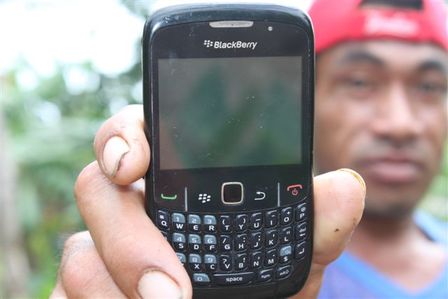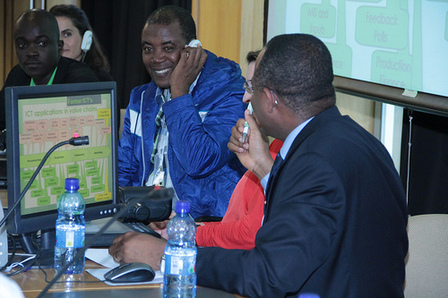Mobile Farmers
My grandma said to your grandma sitting by the fire: “I just got an SMS that now is the right time to plant cassava and moderate rain is expected on Wednesday. Can you get little Johnny to text back that we have 40kg of sweet potato to be picked up in the morning for the snack factory?”
The scenario is rock ‘n roll fiction but based on real developments happening on smallholder farms around the globe.
Mobile phones have become the centre of information communication technologies (ICTs) that are strengthening the link between smallholder farms and markets. Sometimes they are the link.

Add 3G technology, and mobile phones can simultaneously supply smallholder farms with domestic, national and international market information, aggregate real-time agricultural produce volumes and provide buyer markets with supply information. Mobile phones can also track and record provenance and quality through production stages and monitor and evaluate through a burgeoning number of agricultural mobile applications.
For African, Caribbean and Pacific (ACP) nations, mobile phones offer some obvious economic solutions and not-so-obvious social benefits. Yes, they are proving to be a key element in coaching farmers in agribusiness, linking farmers into value chains and even as vital communication tools in disaster preparedness.
But, the technology also has the potential to knit together a cohesive farming community, engage youth in farming practices (because it is youth who have been instrumental in teaming up with farmer parents to use mobile phones for more than voice calling). They have made farming sexy. The latter point is essential to give the industry a much-needed image boost and attract new generations of farmers, who often leave the countryside for the cities.
This week 500 private sector representatives, government officials, farming organisations, civil societies, academics and donors from ACP nations gathered in Addis Ababa, Ethiopia, to discuss how best smallholder farmers could be included in value chains in a way that transformed them from smallholder to entrepreneur.
Making the Connections: value chains for transforming smallholder agriculture was organised by The Technical Centre for Agricultural and Rural Cooperation (CTA), which is based in the Netherlands and funded by the European Union.
On the agenda are many factors that will create an economic, social and political environment in which smallholders can flourish.
A recurring element in the meeting is mobile phone services and how they can be best used by, and for, smallholders.
The breakout session Mobile services strengthening agricultural value chains for smallholders: trends, issues and prospects brought together farmer organisations, government agencies, and software developers.
 Peter Thompson is Eastern Zonal Director at the Rural Agricultural Development Authority (RADA) in Jamaica. He gave a practical example of mobiles services at play.
Peter Thompson is Eastern Zonal Director at the Rural Agricultural Development Authority (RADA) in Jamaica. He gave a practical example of mobiles services at play.
To get his project running, RADA teamed up with Digicel, an emerging mobile phone player and major mover in the island countries gaining a reputation for community-based projects. This year, Digicel Group chairman and founder Denis O’Brien received a much-coveted award for Leadership in the Corporate Sector from the Clinton Global Initiative.
The farmers use basic phones with SMS and voice messaging, while the field workers have 3G phones to connect them to headquarters so they can instantly update their records.
“We use text messages to tell farmers of planting seasons, disseminate market information on prices and what crops are available because some of the farmers are also traders. We are now working on a platform where farmers can dial in for information – for example, pressing 1 for yam and 2 for coffee and so on – then access a second menu on land preparation, marketing, seeds, crops, weather changes, pests, diseases and so on,” says Thompson
The net results have been good for RADA and for the famers.
“For the Irish potato crop that we established in 2010/2011, we have seen a 70 per cent increase in production that was attributed to the text messaging service combined with best practices.”
Arranging meetings with farmers too is now done by SMS rather than driving to individual farms to notify them, saving RADA time and petrol money.
Now other organisations such as the UN Food and Agricultural Organisation are wanting to piggy back on the service.
Mobile networks also have a secondary use in disaster preparedness. Thompson used his established mobile network to help his farmers prepare for Hurricane Sandy.
Farmers were told via SMS to dismantle greenhouses and put seedlings into more secure areas, to take livestock to higher ground or indoor, and take vine crops off their supporting sticks and lay them on the ground.
Farmers were also kept up to date about the wind speed and the severity of the hurricane.
Thompson says the programme has not been without its hitches but every time something new was added to the service, it was piloted with a small group before a general roll-out.
One of the lessons learned has been that the more farmers are bombarded with the information, the more they respond.
Two years in, Thompson says the project – although economically more efficient than extension officers driving to individual farms to conduct training and gathering producer information – has been expensive.
“Even with a 25 percent discount from Digicel, it costs. Farmers need to know not everything is free and there are costs. So there is a question on how do you sustain a project such as this.”
He advises that anyone wanting to run a similar project should contemplate private sector partnership.
Hillary Miller-Wise is deputy regional director for West and Southern Africa for Technoserv, a United States-based non-profit organisation that works to build competitive farms, business and industries.
She says ICT strategies with multiple stakeholders need to make sure their incentives are aligned and the business model is viable.
“We have an ecosystem of partners who bring specialisation and we have learned that each must have defined roles and responsibilities, otherwise the leadership is diluted.
“You must also understand the value addition of each player and whether to include them or not. And lastly, you must simplify, simplify, simplify.”
The advice sounds solid and easy to follow but the choices a farming organisation has around agronomic mobile applications are many, and are complicated by the rapid growth in this industry.
Shaun Ferris from Catholic Relief Services says it is a case of individual solutions.
His slide that intended to capture the software choices available along the value chain starting from preproduction, through to production, post-harvest and marketing illustrated how confusing it could be for newcomers to ICTs.
It’s okay to be confused, says Esoko founder and CEO Mark Davies.
“Developers are driven by a mission to produce new services that will assist farmers so we are seeing many options being offered. This is normal for this transitional stage of development.”
Based in Ghana, Esoko is a mobile-enabled, cloud-based service that collects and provides content such as prices, bids and offers, weather, and agricultural tips to which users can subscribe. It is also provides tools for organizations to manage their own information.
Davies is aware of the benefits Esoko offers to farmers, but even he was recently surprised when conducting a feedback session with farmers, who wrote what the pros and cons were for them on stick notes. One farmer wrote that Esoko had helped resolve marriage conflict.
The farmer explained that there was often distrust between whoever went to the market and whoever stayed home as to whether the full amount of money earned was actually making it back to the farm. But now with the daily market prices being sent to their mobile phone, that was no longer an issue.
In the Pacific, using mobile phones to strengthen smallholder farmer participation in value chains is still in its infancy.
Earlier this year regional organisation, Secretariat of the Pacific Community ran a competition examining the role of ICTs in agriculture by Pacific youth and smallholder agriculture enterprises. In the smallholder category, there were only two entries and the competition was shelved.
One of the entries was Women in Business Development Inc from Samoa – a market-oriented NGO geared to developing sustainable village economies.
For Women in Business, the competition entry provided enough baseline data to develop an ICT pilot, which sits inside the organisation’s communication strategy called Fa’ato’a Samoa, or Cultivate Samoa.
In the Pacific, farmers face various challenges including geographic isolation, which make it hard for farmers to link to export markets. Farmers are widely scattered and work in isolation so there is little communication between them. Their ability to discuss joint ventures, learned processes and share resources is limited.
Also, agriculture has lacked resources and languished as an occupation or career; depriving it of workers, investment and focus.
Another challenge is combating the prevailing thinking that New Zealand and Australia hold the key to income generation for rural Pacific families, resulting in a lack of available labour to work the family farm.
Throughout the ACP region smallholder farmers trade in small volumes, which affects security of contracts. And, farmers’ skills have not been updated to meet modern expectations or market demands of production and packaging standards.
For Women in Business, its main commodity is virgin coconut oil, which it sells to The Body Shop through its Community Fair Trade programme. The 21-year-old organisation is funded by the New Zealand Government through Oxfam NZ and the Canada Fund.
It has more than 700 organically-certified farmers through the National Association for Sustainable Agriculture, Australia. It also does not have enough staff to keep in regular contact with all its farmers.
However, the proliferation of affordable cellphones throughout Samoa has aided communication between Women in Business staff and farmers.
The organisation’s ICT pilot, which will work with several clusters within its farming members, takes what is already working – such as farmers using a simple “call me” free text to let extension workers know they need assistance – and amplifies it through the addition of some other elements, including monitoring and evaluation tools.
Women in Business executive director Adimaimalaga Tafuna’i says the strategy will provide a level of connectedness for the organisation with its farmer members that would otherwise be unachievable.
“We consciously developed our ICT pilot to sit inside our communications strategy because we see mobile phones as complimentary to all our outreach work with web, radio, print and television. With all these media working together, we anticipate an acceleration of positive results right along the value chain.”
Tafuna’i says Women in Business will measure the success of the strategy through the increase of farmer income achieved through greater efficiency of farmer-to-market processes.
Although the organisation will conduct the first batch of training, “it will be farmers that will become the trainers of successive groups.
“You cannot keep treating farmers as students; otherwise they will always remain students. They know the language of their peers and the challenges.”
The strategy is currently awaiting approval in the offices of PACMAS, the Pacific Media Assistance Scheme funded by Australian Aid. Women in Business has also approached Digicel Samoa to discuss a partnership, based on the fact an increase in farming income would also see an increase in profits for the company. After seeing a post in a regional forum about Women in Business’ ICTs project, Apidae, a Melbourne-based social and technology development innovation company, is coming on board to implement their monitoring and evaluation ICT tools. It is also offering to do the work pro bono. Apidae co-founder, Adam Bumpus, who is an Assistant Professor at the University of Melbourne, says the pilot is “exciting and pioneering for the Pacific islands”.
Knowing that donor project funding and private sector support usually comes with an expiry date, Women in Business will look to levy farmers who want to stay in the mobile programme. It is after all business.
Tafuna’i says even if the funding doesn’t come through, the organisation will still implement the strategy - it will just take longer than anticipated.
That begs the question, does every smallholder organisation need to use mobile networks to access and strengthen value chains?
Fritz Brugger from Syngenta Foundation says the key is to identify the problem. If mobile services are part of the solution, then use them.
K-Farm director Kit Chan says he does not use mobile services in his farmer organisation, which has been operating in Malaysia for more than 25 years.
Chan adds that his farmers are a small, tight-knit group so there is not an issue of farmers being disconnected from value chains.
The K-Farm website sums it up saying: “The real secret of our success is that we are one extended family doing the job with commitment and satisfaction. We are in the total supply chain from planning to planting to harvesting and to marketing.”
For less-established farmer organisations, agricultural economist Dr Irene Susan Egyir counters that mobile phones and computers are important for farmers to become entrepreneurs.
Egyir lectures at the University of Ghana and says mobile phones and computers can capture the farm data about crops and yield that the farmer can use in the future. She adds that farm organisations should also become farm management centres.
She points out there are barriers to mobile services being effective. Remote areas in Africa have poor networks as do some of the islands in the Pacific and Caribbean.
The cost of mobile phone credit and data too can be prohibitive. Also, there are the electricity costs to consider for recharging phones.
Egyir adds that even with an effective mobile service, farmers will still want to check the information being sent to them.
“Data has shown that people still want to verify the information from trusted friends and neighbours. Extension workers will still have put up social capital to keep the trust of farmers.”
In the meantime, farmer organisations have many decisions to make around implementing mobile services as some of the barriers cleared away regarding network penetration and the settling down of the market information systems industry. Perhaps with all this complexity, Hillary Miller-Wise’s words need to be heeded: “Simplify, simplify, simplify.”
Posted: Fri 23 Nov 2012

